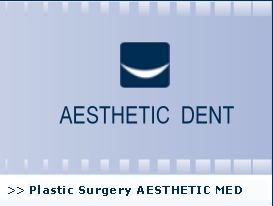 |
 |
|
 |
|||||||||||||||
| IMPLANTOLOGICAL TREATMENT IMPLANTS In case of missing teeth (one tooth or all teeth) implants are
used to fix the prosthetics fillings. They are mainly recommended
when the patient doesn't tolerate other dentures (e.g. retch reflex,
feeling of a foreign body in the mouth, fear of an unexpected loosening)
or when the teeth have to be polished to replace lost teeth. Implants
are of special importance in cases of a toothless mouth. Sometimes
two implants are sufficient to improve the quality of life substantially
and to even make the eating of hard food possible. |
 |
|
||||||||||||||
| DENTURES BRIDGES AND PORCELAIN CROWNS Prosthetic fillings are fixed onto the own teeth of the patient.
Here even a reduced number of own teeth is sufficient for a reconstruction
of a "complete smile". Prosthetic crowns are used in
cases of a severe damage of crown parts due to caries, breaks and/or
tooth attritions. The loss of own teeth allows the manufacturing
of bridges. These fillings are fixed at the own teeth - that are
accordingly prepared - by means of cement. Thus they can be used
just like own teeth. The necessary materials guarantee stable and
fix constructions for a long period of time. |
 |
|||||||||||||||
| METAL-FREE CERAMIC CROWNS BY PROCER
Today more and more porcelain crowns without the traditional metallic
basis are used. The newest achievements in the field of dentures
technology tend to use such fillings that are homogenous in their
structure and that are being tolerated by the organism. In the
end, the manufactured teeth have a natural appearance that is completely
integrated alongside with the neighbouring teeth. The stability
of the metal-free porcelain crowns is the same as that of traditional
ones with metal. |
 |
|||||||||||||||
| BRACKETLESS DENTURES
These dentures replace mainly part and bone dentures. The precise
elements in the form of clasps and snappers that are used in the
dentures allow to elementize non-cosmetic metal brackets. This
leads to better aesthetics and functionality, and to the maintenance
of the dentures. They protect the remaining teeth from mechanical
injuries that occur due to frictions of the brackets alongside
the supporting teeth. They are in their use as comfortable as fillings
that are fixly inserted in the mouth. |
 |
|||||||||||||||
| OVERDENTURES
These are dentures that use single roots for the fixation. In
this case the remaining roots take over the role of "natural
implantations" that are used for the fixation of dentures.
Overdentures keep their fix position on their basis mainly thanks
to the application of snap elements that are integrated in the
root. These elements become invisible after the insertion of the
dentures into the mouth. The existing roots have therefore also
a prophylactic function as they postpone the bone atrophy. |
 |
|||||||||||||||
| OPERATIVE DENTISTRY CONTROLLED BONE REGENERATION The traditional surgery is one of the oldest fields of stomatology but today it is used rarer and rarer. The available services in preservation treatments led to the fact that the tooth extraction is a measure that is hardly carried out any more. The techniques used today are aimed at keeping the tooth or parts of it instead of having to extract it. A great problem for patients is the bone atrophy that is caused by predantium diseases or by injuries. This very much reduces the possibilities to replace tooth losses aethetically. The controlled regeneration, whereby osteogenetic osteoid (bone-like) substances are used, makes the extension of the missing bone possible. This plays a major role in those cases where no sufficient bone substance is left as a basis for implants. TEETH AESTHETIC Bright coloured teeth are the dream of every human being. But nature has given us teeth with many different shades that are very often different from our ideal. With the help of non-invasive and completely safe substances a brightening of teeth by 2 - 3 colour degrees is possible. In case of the recolouration of the teeth this results in a quite positive effect within 10 to 14 days. It has also yet another advantage. This measure can be carried out by the patient himself at home without the assistance of a doctor. TREATMENT OF PERIODONTOSIS Periodontosis can be observed with many patients. The problem of bleeding of the gums or of loosening teeth is well-known. Often it is wrongly assumed that a treatment will not be successful. But help that is provided early enough can slow down the disease process so the teeth can be preserved. CONSERVATION TREATMENT The restauration of the natural tooth colour and the tooth profile is possible with the help of the application of simple dental techniques. The changes that are caused by caries or injuries can be reconstructed within a very short time. This makes a successful and aesthetic solution of the previous problems possible. ORTHODONTICS The orthodontic treatment gives the opportunity to remove teeth anomalies by means of fix apparatures. These make a correct and regular posting of the teeth and therefore in the end an aesthetic appearance possible. |
||||||||||||||||